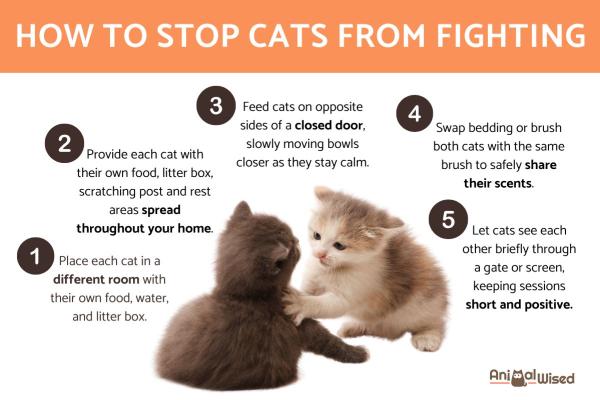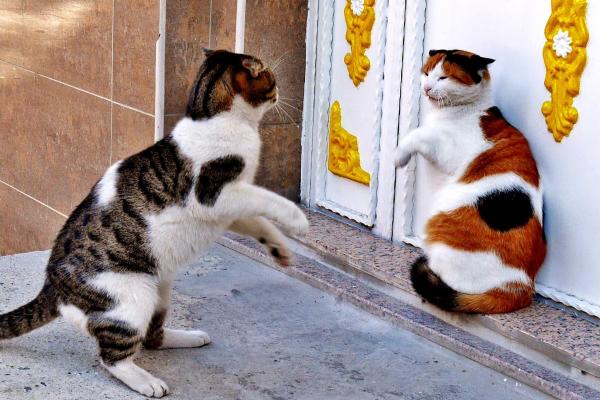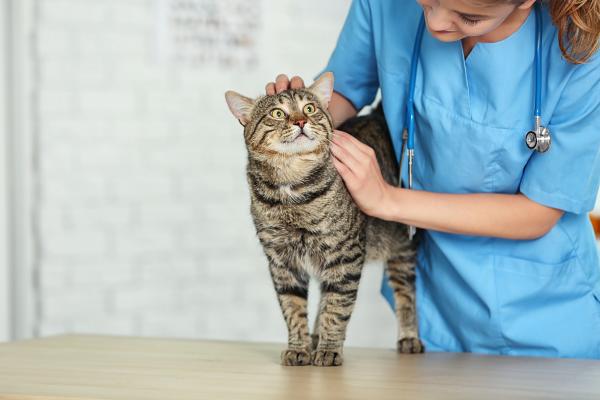
Cat fights can be tough on everyone, both you and your furry friends. But don't worry, with a little patience and the right approach, you can help your cats get along better. While the occasional spat is normal, constant fighting isn't. The trick is to break those bad habits and create a calm and secure environment for both of them. These simple steps can help ease the tension and bring some peace back to your home. Just remember, every cat is different, so you might need to adjust the timing of these steps depending on how your cats react.
This AnimalWised article explains how to stop your cats from fighting, covering common causes, effective solutions, and when to seek professional help.
Why do cats fight?
Cats fight for a variety of reasons, stemming from both their instincts and their surroundings. However, at the core of many conflicts lies territorial behavior, cats naturally establish and defend specific areas they consider their domain. These territorial disputes can occur both outdoors and within homes, often triggered when one cat perceives an intrusion into their established space.
The complex social dynamics between cats also contribute to fighting behavior. Unlike more rigidly hierarchical animals, cats maintain fluid social relationships that require ongoing negotiation. This can lead to fights, especially in multi-cat households, as they try to establish dominance. These disputes often start with subtle body language before escalating into physical altercations.
Stress and environmental changes represent significant triggers for feline aggression. Cats may react defensively during stressful events such as moving, veterinary visits, or disruptions to their routine. Pain or illness can also make a cat lash out. Even something as simple as a cat smelling different after a trip to the vet can spark aggression from other cats in the household.
Hormones, especially in males, can be a factor, particularly when females are in heat. And, of course, a cat's predatory instincts can sometimes be misdirected towards other cats.
[ltmbox id="t0OA5XRc" label="Interested in a Calming Diffuser? Click Here to Shop"]
How can I tell if my cats are fighting or playing?
One of the most important aspects of managing cat behavior is distinguishing between genuine fighting and play fighting. During play, cats display controlled movements, take turns, and generally avoid causing harm.
In contrast, real fights involve intense vocalizations, defensive posturing, and more aggressive physical contact. It is important for owners to understand this difference in order to avoid accidentally rewarding aggressive behavior.
Worried about your cats' roughhousing? Discover more information about how to distinguish between normal play and actual aggression in our related guide.

How do you know when to break up a cat fight?
Recognizing the warning signs of aggression in cats is key to preventing full-blown fights. Cats give off a number of signals before things turn physical, and observant owners can often step in and defuse the situation.
Early warning signs include things like a puffed-up or rapidly swishing tail, flattened ears, and intense staring between cats. These subtle cues often come before more obvious aggression.
As tension builds, cats typically progress to more overt aggressive behaviors. These include hissing, growling, and changes in body posture, such as arched backs, sideways positioning, and fur standing on end. A cat may also display defensive postures, crouching low to the ground or backing into a corner while maintaining aggressive vocalizations.
Knowing when to intervene is crucial. If you catch the early warning signs, you can often distract the cats or create some distance between them to prevent things from going further. However, once they're actually fighting, you need to be very careful not to get hurt yourself.
You should definitely intervene immediately if you see any of these signs:
- Loud, prolonged vocalizations.
- Rolling fights where neither cat seems to be backing down.
- One cat clearly trying to escape but being chased.
- Any sign of drawn blood or intent to cause serious injury.
Every cat owner should know what to do after a cat bite. Learn the crucial next steps in our detailed guide.

How to stop cats from fighting
Serious cat fights require quick, careful action. The safest way to break up a fight is to create a sudden, startling distraction. Try clapping your hands loudly, banging a pot, or using a loud whistle.
If that doesn't work, you can try spraying water away from the cats (never directly at them). It's crucial to stay safe, so use a barrier like a large piece of cardboard or a cushion if you need to get closer.
Never try to physically separate fighting cats with your hands or by grabbing them. This is a recipe for serious injury, as cats in fight mode may redirect their aggression toward you.
Also, avoid punishing the cats after a fight. This will only increase their stress and anxiety, potentially leading to more aggression.
How to reintroduce cats after a fight:
Reintroducing cats after a fight requires a structured approach:
- Give each cat their own space, complete with food, water, litter box, and resting areas. This cooling-off period can last days or even weeks.
- Exchange bedding or toys between the cats so they can get used to each other's scent again in a non-threatening way.
- Make sure you have plenty of resources throughout your home to reduce competition. The rule of thumb is one resource per cat plus one extra. So, if you have two cats, you should have at least three feeding stations, litter boxes, scratching posts, and elevated resting spots. Place these resources in different locations to minimize territorial disputes.
- Consider using pheromone diffusers, especially in shared spaces. These release calming pheromones that can help reduce tension and anxiety.
Is one of your cats showing dominant behavior? Learn to recognize and manage alpha cat dynamics in our detailed guide.

How to create a harmonious multi-cat household
For a peaceful multi-cat home, you'll need to do some training and behavior modification. These include:
- Positive reinforcement: reward calm behavior with treats, praise, or attention. This helps them associate positive feelings with each other's presence.
- Interactive play: Regular play sessions with each cat individually, using wand toys or laser pointers, are a great way to redirect aggressive energy and strengthen your bond with each cat.
- Clicker training: Clicker training can be very effective. Start by teaching each cat basic commands separately, then gradually work on training them together. The click sound becomes associated with positive experiences.
- Socialization: Start with supervised visual contact through a baby gate or screen door, rewarding calm behavior. Gradually progress to controlled interactions in neutral territory, keeping sessions short and positive.
Patience and consistency are key. It can take weeks or even months for cats to establish a peaceful relationship, and some may only ever achieve a tolerant coexistence. Respect each cat's individual pace and never force interactions.
When to seek professional help
Sometimes, even the most dedicated owner can't resolve cat conflicts on their own. It's important to know when to seek professional help. A sudden change in a cat's behavior, especially if they were previously friendly, could signal an underlying medical issue. Things like hyperthyroidism, dental problems, or neurological issues can make cats irritable and aggressive, so a vet check-up is essential.
Chronic stress and anxiety can also lead to persistent aggression. If your cat's behavior changes (appetite, excessive grooming, inappropriate elimination, or constant hiding) and they're also aggressive, it's time to talk to a qualified veterinarian or a certified cat behaviorist.
You should definitely seek professional help if:
- Your cat has frequent, unprovoked attacks.
- The aggression is causing injuries.
- The behavior is disrupting your household.
- You've tried reintroducing your cats using proper methods, but it's not working.
- The aggression isn't improving over time.
A cat behaviorist can offer personalized strategies, including detailed plans for changing your cat's environment and specific behavior modification techniques. They might also recommend anti-anxiety medication (in consultation with your vet), especially if the aggression is rooted in fear or anxiety. Wondering how long it will take for your cats to become friends? Our guide to cat bonding timelines has all the answers.

If you want to read similar articles to How to Stop Your Cats from Fighting, we recommend you visit our Behavioral problems category.
Crowell-Davis, S. L. (2007). Cat behaviour: Social organization, communication and development. In I. Rochlitz (Ed.), The Welfare of Cats (pp. 1–22). Springer. https://link.springer.com/chapter/10.1007/978-1-4020-3227-1_1
Turner, D. C. (2021). Unanswered questions and hypotheses about domestic cat behavior, ecology, and the cat–human relationship. Animals, 11(10), 2823. https://www.ncbi.nlm.nih.gov/pmc/articles/PMC8532687